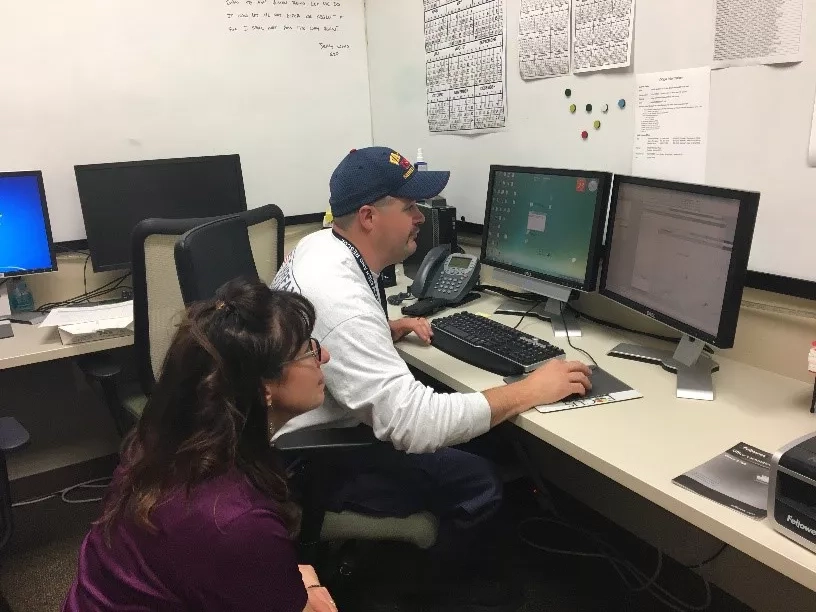Lori Schultz excels at puzzles, but her puzzles involve satellites – not cardboard. Her sharp eye for detail and quick wit help her answer some of NASA's most critical disaster questions. But how does she do it?
When disasters strike, response agencies from around the world reach out to NASA for information. It’s up to Schultz and her team members to parse through NASA’s satellite data and determine how we can help. They serve as the link between operational organizations and NASA’s science – a team of ‘satellite translators,’ if you will. Schultz knows the instruments’ capabilities and won’t hesitate to let people know if there’s a better tool for the job. You can hear the excitement in her voice when she puts the pieces together to help others see the “picture” that emerges.
It’s no surprise, then, that when global organizations need a remote sensing expert for severe weather, Schultz is on the shortlist. Yet, it may come as a surprise that she didn’t get into the sciences until she was 28 years old.
After graduating high school, Schultz joined the U.S. Army for nine years. There, she served as a helicopter mechanic; a career that quite literally reflects her talent at putting the pieces together. While she enjoyed being a mechanic, the job was too physically demanding to do forever. “I would probably still be fixing helicopters if it wasn’t so blasted hard on the body.” On top of the physical stress, her position was time-consuming. It also kept her away from her son for extended periods. The final straw occurred when she returned from a five-month deployment for Hurricane Mitch and her young son didn’t recognize her. So, after a brief stint as a reservist, she made the decision to leave the military for good.
Schultz decided to use her newfound free time to go back to school. Her strong aptitude for math and desire to understand how things work led her to enroll in a physics program at Austin Peay State University in Tennessee. Going to college at 28 years old presented a new set of challenges for Schultz. “I had to learn how to be a student again; I had to learn how to study, and I had to face the fact that everything I thought I knew was really, really old.” She had to take remedial courses and recall academic skills from a decade prior, but it didn’t take her long to adjust.
After successfully finishing her physics degree, Schultz planned to apply to an engineering program. However, a research trip to the University of Alabama in Huntsville exposed her to different types of applied science. Rather than study engineering, she decided to pursue an applied sciences master’s degree focusing on weather research. “Solving the actual problem of catching the mouse was much more to my liking than creating a better cage.” A degree in applied sciences would allow Schultz to pursue questions with more tangible ends – a path much more to her liking. But without a background in weather, she had to audit a class every semester to increase her exposure to different weather topics.
“It was jumping not only into the deep end of a pool, but the deep end of a wave pool.”
Schultz’s path to NASA wove around a military career, raising a child, being a non-traditional student, and changes in her career goals, but she wouldn’t change a thing. “If given the opportunity, I would probably do it all again anyway.” A fascination with understanding, paired with a willingness to seek out answers, led her right to NASA. Today, she is a center coordinator for the NASA Applied Sciences Disasters program area. Schultz is also a member of a floods research team, led by Franz Meyer, that uses remote sensing to create flood products. The research team has provided support for flood events such as the Midwest floods in 2019, Australia floods in 2021, or British Colombian floods in 2021, and hurricanes such as Hurricanes Eta and Iota in 2020. Schultz’s previous Central American deployment for Hurricane Mitch prepared her for Hurricanes Eta and Iota over 20 years later. From the research side, she was able to draw on her experience on the ground to help provide the U.S. military and other responders with helpful flood mapping information.
Currently, Schultz excels at teaching end users how to interpret Earth data and does so with unmatched enthusiasm. This past year, she participated in the American Meteorological Society’s (AMS) Project Atmosphere, a program designed to share the latest atmospheric resources and information with science teachers. During the program she got to pass her enthusiasm for Earth data on to science teachers and help them do the same for their future students.
According to Schultz, entering the sciences was an inevitable career outcome. “I was going to end up here regardless.” Whether she’s fixing a helicopter or helping people use NASA resources to make their communities safer from disasters, there isn’t a puzzle that Lori Schultz can’t solve.









